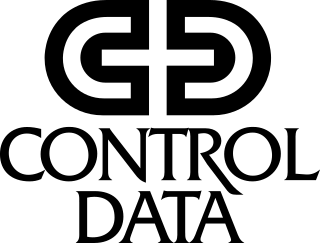
Control Data Corporation (CDC) was a mainframe and supercomputer firm. CDC was one of the nine major United States computer companies through most of the 1960s; the others were IBM, Burroughs Corporation, DEC, NCR, General Electric, Honeywell, RCA, and UNIVAC. CDC was well-known and highly regarded throughout the industry at the time. For most of the 1960s, Seymour Cray worked at CDC and developed a series of machines that were the fastest computers in the world by far, until Cray left the company to found Cray Research (CRI) in the 1970s. After several years of losses in the early 1980s, in 1988 CDC started to leave the computer manufacturing business and sell the related parts of the company, a process that was completed in 1992 with the creation of Control Data Systems, Inc. The remaining businesses of CDC currently operate as Ceridian.
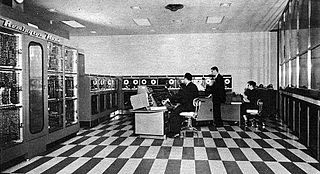
UNIVAC was a line of electronic digital stored-program computers starting with the products of the Eckert–Mauchly Computer Corporation. Later the name was applied to a division of the Remington Rand company and successor organizations.
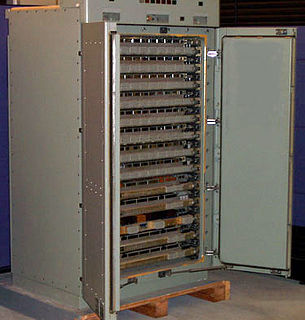
The AN/USQ-20, or CP-642 or Naval Tactical Data System (NTDS), was designed as a more reliable replacement for the Seymour Cray-designed AN/USQ-17 with the same instruction set. The first batch of 17 computers were delivered to the Navy starting in early 1961. A version of the AN/USQ-20 for use by the other military services and NASA was designated the UNIVAC 1206. Another version, designated the G-40, replaced the vacuum tube UNIVAC 1104 in the BOMARC Missile Program.
The AN/UYK-8 was a UNIVAC computer. It used the same 30-bit words and instruction set as the AN/USQ-17 and AN/USQ-20 Naval Tactical Data System (NTDS) computers, built with "first generation integrated circuits" which made it about one quarter of the volume of the AN/USQ-20 and two processors instead of just one.

The UNIVAC 1100/2200 series is a series of compatible 36-bit computer systems, beginning with the UNIVAC 1107 in 1962, initially made by Sperry Rand. The series continues to be supported today by Unisys Corporation as the ClearPath Dorado Series. The solid-state 1107 model number was in the same sequence as the earlier vacuum-tube computers, but the early computers were not compatible with the solid-state successors.

The UNIVAC 1103 or ERA 1103, a successor to the UNIVAC 1101, was a computer system designed by Engineering Research Associates and built by the Remington Rand corporation in October 1953. It was the first computer for which Seymour Cray was credited with design work.
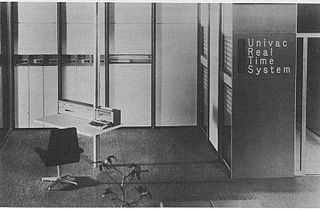
The UNIVAC 490 was a 30-bit word magnetic-core memory machine with 16K or 32K words; 4.8 microsecond cycle time made by UNIVAC. Seymour Cray designed this system before he left UNIVAC to join the early Control Data Corporation.

CMS-2 is an embedded systems programming language used by the United States Navy. It was an early attempt to develop a standardized high-level computer programming language intended to improve code portability and reusability. CMS-2 was developed primarily for the US Navy’s tactical data systems (NTDS).
The UNIVAC III, designed as an improved transistorized replacement for the vacuum tube UNIVAC I and UNIVAC II computers, was introduced in June 1962, with Westinghouse agreeing to furnish system programing and marketing on June 1, 1962. It was designed to be compatible for all data formats. However the word size and instruction set were completely different; this presented significant difficulty as all programs had to be rewritten, so many customers switched to different vendors instead of upgrading existing UNIVACs.
The UNIVAC 418 was a transistorized, 18-bit word core memory machine made by Sperry Univac. The name came from its 4-microsecond memory cycle time and 18-bit word. The assembly language for this class of computers was TRIM III and ART418.

Naval Tactical Data System (NTDS) was a computerized information processing system developed by the United States Navy in the 1950s and first deployed in the early 1960s for use in combat ships. It took reports from multiple sensors on different ships and collated it to produce a single unified map of the battlespace. This information could then be relayed back to the ships and to the weapons operators.

The surface-barrier transistor is a type of transistor developed by Philco in 1953 as an improvement to the alloy-junction transistor and the earlier point-contact transistor. Like the modern Schottky transistor, it offered much higher speed than earlier transistors and used metal–semiconductor junctions, but unlike the schottky transistor, both junctions were metal–semiconductor junctions.
The AN/UYK-20 "Data Processing Set" was a ruggedized small computer manufactured by Univac and used by the United States Navy for small and medium-sized shipboard and shore systems built in the 1970s. It featured non-volatile magnetic core memory and was housed in a heavy-duty metal cube-shaped box which was designed to fit through a 25-inch circular hatch.
The AN/UYK-44 is the standard 16-bit minicomputer of the United States Navy. The AN/UYK-44 was developed in the early 1980s by Sperry Corporation and was completed in early 1984. The AN/UYK-44 was used in surface ships, submarines, ground C4I platforms, radar and missile control systems. The system was designed to replace the older AN/UYK-20 model.
The AN/UYK-7 was the standard 32-bit computer of the United States Navy for surface ship and submarine platforms, starting in 1970. It was used in the Navy's NTDS & Aegis combat systems and U.S. Coast Guard, and the navies of U.S. allies. It was also used by the U.S. Army. Built by UNIVAC, it used integrated circuits, had 18-bit addressing and could support multiple CPUs and I/O controllers. Its multiprocessor architecture was based upon the UNIVAC 1108. An airborne version, the UNIVAC 1832, was also produced.
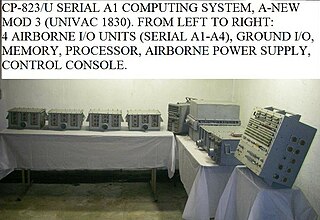
The CP-823/U, Univac 1830, was the first digital airborne 30-bit computing system. It was engineered, built and tested as the A-NEW MOD3 prototype computer for the Lockheed P-3 Orion.

The UNIVAC 9000 series was a line of computers introduced by Sperry Rand in the mid-1960s to compete with the low end of the IBM System/360 series. The 9200 and 9300 implemented the same restricted 16-bit subset of the System/360 instruction set as the IBM 360/20, while the UNIVAC 9400 implemented a subset of the full 32-bit System/360 instruction set. The 9400 was roughly equivalent to the IBM 360/30.
Howard T. Engstrom was a Yale University mathematics professor and headed research operations at the United States Navy's Communication Supplementary Activities CSAW during World War II. Along with William Norris and others he founded Engineering Research Associates in 1946. He was one of the co-creators of the Univac computer, and served as deputy director of the National Security Agency.
Marine Tactical Data System, commonly known as MTDS, was a mobile, ground based, aviation command and control system developed by the United States Marine Corps for the execution of anti-air warfare in support of the Fleet Marine Force (FMF). It was the Marine Corps' first semi-automated system capable of collecting, processing, computing and displaying aircraft surveillance data while also sharing that information with other participating units via tactical data link. The system was developed in the late 1950s/early 1960s when it was recognized that due to the speed, range and complexity of fighter aircraft operations effective air control and air defense demanded enhanced situational awareness.










